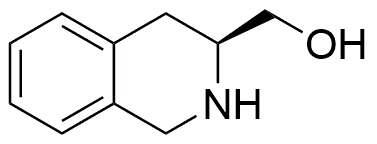(S)-(-)-1,2,3,4-Tetrahydro-3-isoquinolinemethanol is widely utilized in research focused on:
- Pharmaceutical Development: This compound serves as a key intermediate in the synthesis of various pharmaceuticals, particularly those targeting neurological disorders. Its unique structure allows for the development of drugs with enhanced efficacy and reduced side effects.
- Neuroscience Research: Researchers use this chemical to study its effects on neurotransmitter systems, which can lead to a better understanding of mental health conditions and the development of new therapeutic strategies.
- Analytical Chemistry: The compound is employed in analytical methods to detect and quantify isoquinoline derivatives, aiding in quality control processes in the pharmaceutical industry.
- Natural Product Synthesis: It is utilized in the synthesis of natural products that exhibit biological activity, making it valuable for researchers in medicinal chemistry and drug discovery.
- Biochemical Studies: This chemical is used in various biochemical assays to explore its interaction with biological targets, providing insights into potential therapeutic applications.
General Information
Properties
Safety and Regulations
Applications
(S)-(-)-1,2,3,4-Tetrahydro-3-isoquinolinemethanol is widely utilized in research focused on:
- Pharmaceutical Development: This compound serves as a key intermediate in the synthesis of various pharmaceuticals, particularly those targeting neurological disorders. Its unique structure allows for the development of drugs with enhanced efficacy and reduced side effects.
- Neuroscience Research: Researchers use this chemical to study its effects on neurotransmitter systems, which can lead to a better understanding of mental health conditions and the development of new therapeutic strategies.
- Analytical Chemistry: The compound is employed in analytical methods to detect and quantify isoquinoline derivatives, aiding in quality control processes in the pharmaceutical industry.
- Natural Product Synthesis: It is utilized in the synthesis of natural products that exhibit biological activity, making it valuable for researchers in medicinal chemistry and drug discovery.
- Biochemical Studies: This chemical is used in various biochemical assays to explore its interaction with biological targets, providing insights into potential therapeutic applications.
Documents
Safety Data Sheets (SDS)
The SDS provides comprehensive safety information on handling, storage, and disposal of the product.
Product Specification (PS)
The PS provides a comprehensive breakdown of the product’s properties, including chemical composition, physical state, purity, and storage requirements. It also details acceptable quality ranges and the product's intended applications.
Certificates of Analysis (COA)
Search for Certificates of Analysis (COA) by entering the products Lot Number. Lot and Batch Numbers can be found on a product’s label following the words ‘Lot’ or ‘Batch’.
*Catalog Number
*Lot Number
Certificates Of Origin (COO)
This COO confirms the country where the product was manufactured, and also details the materials and components used in it and whether it is derived from natural, synthetic, or other specific sources. This certificate may be required for customs, trade, and regulatory compliance.
*Catalog Number
*Lot Number
Safety Data Sheets (SDS)
The SDS provides comprehensive safety information on handling, storage, and disposal of the product.
DownloadProduct Specification (PS)
The PS provides a comprehensive breakdown of the product’s properties, including chemical composition, physical state, purity, and storage requirements. It also details acceptable quality ranges and the product's intended applications.
DownloadCertificates of Analysis (COA)
Search for Certificates of Analysis (COA) by entering the products Lot Number. Lot and Batch Numbers can be found on a product’s label following the words ‘Lot’ or ‘Batch’.
*Catalog Number
*Lot Number
Certificates Of Origin (COO)
This COO confirms the country where the product was manufactured, and also details the materials and components used in it and whether it is derived from natural, synthetic, or other specific sources. This certificate may be required for customs, trade, and regulatory compliance.

